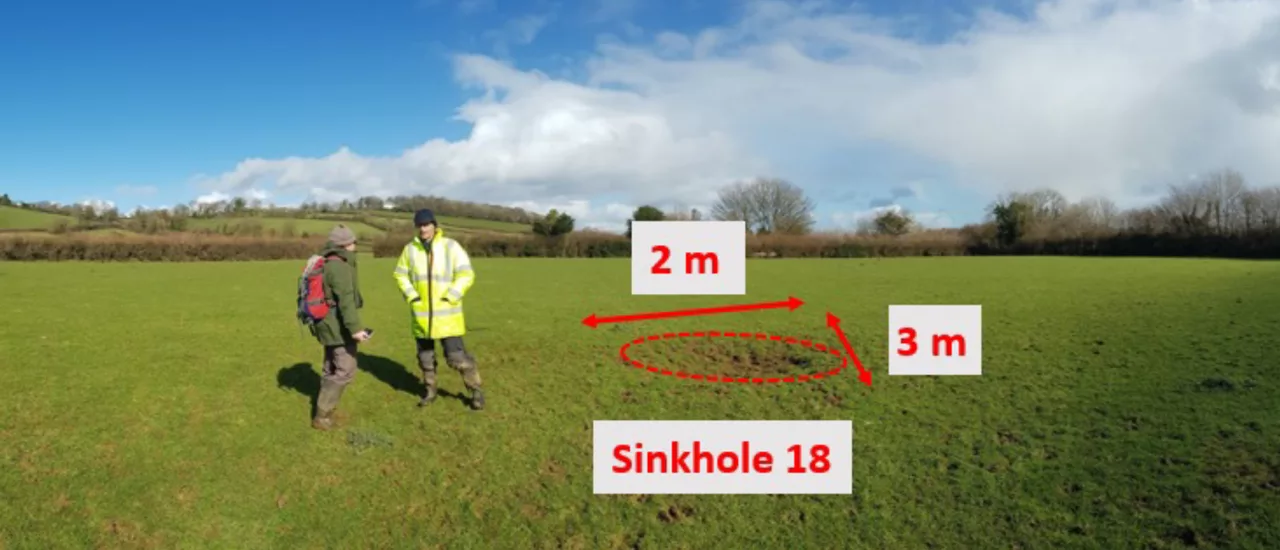A project-specific classification of sinkholes has been developed based on surface morphology, meaning it can be applied readily through visual inspection of a sinkhole or suspected sinkhole, aided by knowledge of surface water management. The three project-specific classes of sinkhole are described below and illustrated in the diagrams.
The majority of the Class A and B sinkholes shown on the map are believed to have originally developed in association with surface water flow, even where water was not apparent during field walkover inspections.
The three classes of sinkholes identified within the vicinity of the quarry are as follows:
Class A sinkholes are large bowl-shaped depressions. These depressions probably developed in ancient geological time and hence Class A sinkholes are likely to be long-term features of the landscape. The ‘type’ locality for this class of sinkhole is at the A38 off-slip road sinkhole at Goodstone Cross. Highways England has advised that this sinkhole was present when the slip road was constructed.


As Class A sinkholes are long term features which have developed over a geological timescale, new Class A sinkholes are not expected to be detected. However, because they are depressions in the ground within which rainwater collects, Class A sinkholes can act as a focal point for the formation of Class B and C sinkholes.
In March 2014, new Class B and C sinkholes developed within the Class A sinkhole at the A38 off-slip road at Goodstone Cross. The likely trigger for the Class B sinkhole was excess surface water collecting in the pre-existing depression in the ditch adjacent to the slip road, resulting in a concentration of surface water. The Class C sinkhole formed in the field adjacent to the foot of the slip road’s embankment, most likely triggered by the same concentration of surface water, but also by surface water runoff from the higher parts of the field collecting within the pre-existing Class A depression.
Class B sinkholes are small steep-sided depressions, with no evidence of influence from surface water flow or infiltration. Generally 0.5 to 3 m in diameter, Class B sinkholes develop over engineering timescales (in contrast to Class A sinkholes) and may form within a Class A sinkhole. The ‘type’ locality for this class of sinkhole is near the centre of a field approximately 300 m to the southeast of Alston Farmhouse, denoted as sinkhole 18 in the figure below.


A few of the Class B sinkholes that have been mapped in the vicinity of the quarry may have formed as Class C sinkholes historically under different hydrological or hydrogeological conditions, but at the time of inspections there was no evidence to suggest recent water inflow, despite inspections having been carried out during winter. Class B sinkholes may also have formed due to the collapse of the overlying soil into the void as a result of the migration of water and the erosion of sediment-filled conduits or cavities beneath the ground surface, with the subsequent collapse of the overlying soil into the void.
Class C sinkholes are small steep-sided depressions, generally 0.5 to 3 m in diameter, which develop over engineering timescales (in contrast to Class A sinkholes), Class C sinkholes may form within a Class A sinkhole. Class C sinkholes are formed only in association with surface water flow, such as at field boundary ditches, streams, or where surface water is poorly controlled (i.e. a route of excess overland flow or where ponding commonly occurs, especially during heavy rainfall events).
The ‘type’ location of this class of sinkhole is in a field approximately 200 m southwest of Alston Farmhouse, in which there is a cluster of three Class C sinkholes (denoted as sinkholes 5, 6 and 7 in the figure below).








